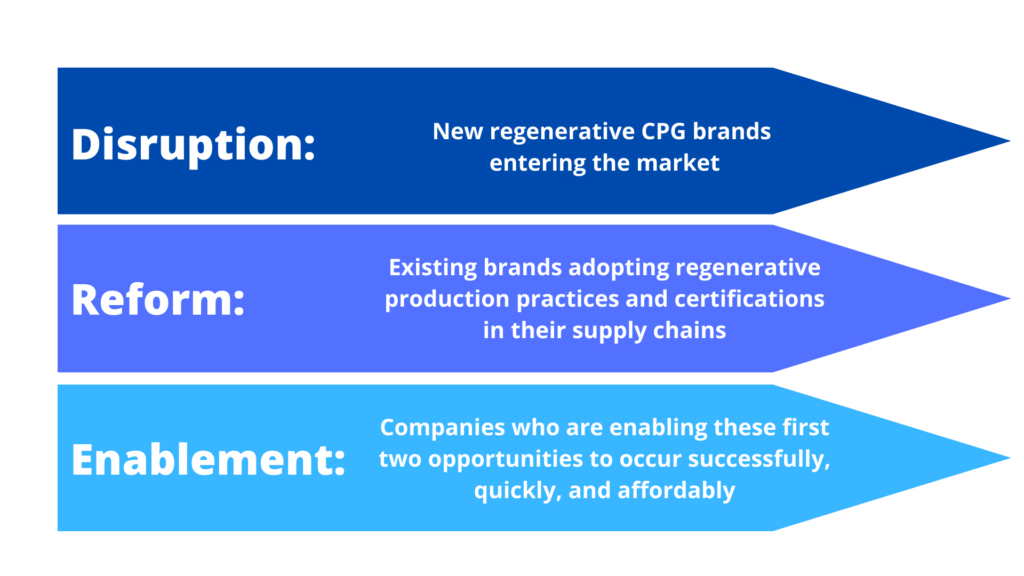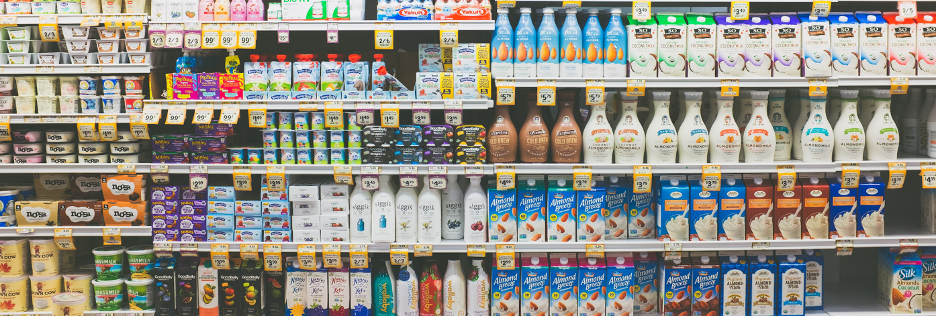For regenerative CPG, 2022 has brought much to be encouraged about. In particular, the Natural Products Expo West served as a powerful litmus for where we are today. Content about regenerative agriculture was well represented in the event’s programming and at least 53 of the 2800 exhibitors explicitly supported regenerative agriculture – representing a significant increase in presence on the expo floor. While this only constituted 1.9% of all exhibitors in this particular natural products space – suggesting that the overall percentage of regenerative products in the entire CPG industry is well below 1.9% – there is still room for optimism… and increased investment.
Ryan Springer is a Founding Partner at Midnight Venture Partners – a venture capital firm investing in consumer brands creating products and services shaping the next generation of wellness. Ryan summed up the state of regen at Expo well. “I’ve been going to Expo West for almost a decade, and this was the first year that I felt regenerative brands had a real noticeable presence. That being said, it was still very small: I think I saw more plant-based chicken nuggets than all of the regen brands I saw put together. That’s how changes start in CPG though, and things can move fast once they pick up momentum.”
The Investment Opportunities:
The significant and growing momentum behind regenerative creates three massive opportunities for investment:
1. Disruption: The space is ripe for new challenger brands to enter the market and be disruptive while gaining market share. This will lead to successful exits through private equity acquisitions, IPO’s (initial public offerings), or acquisitions by legacy CPG companies looking to diversify and “clean up” their portfolio of brands. Perdue’s purchase of Pasturebird in 2019 being one early example of this, where Perdue Farms saw value in both Pasturebird’s existing business and their proprietary technology for raising pastured chicken.
2. Reform: These same market share dominant incumbents might opt to “clean up” their current portfolios from within by investing in the adoption of regenerative production practices and certifications in the existing supply chains of their brands. This is clearly already underway in a major way (See General Mills, Kellogg, Unilever, and many more). Some of these companies may choose to pursue a blended approach of both acquisitions and internal supply chain revamp.
3. Enablement: Lastly, any and all companies who are enabling these first two opportunities to occur successfully, quickly, and affordably through financing, land management, technical assistance, technology, or otherwise are setting themselves up to be gateways for compelling returns. Examples include innovative financial players like rePlant Capital and Mad Agriculture. Also, technical assistance providers like Understanding Ag, who is doubling down on their work by adding the Regeneified Verification to their offerings. Their work now spanning all the way from on-farm practice implementation to final product packaging verification – working in an intimate and deeply consultative fashion with major food brands to create regenerative supply chains. And technology companies like HowGood, Planet FWD, Yard Stick, and ReGrow who will be the data engines and MRV (monitoring, reporting, and verification) technology that proves out sustainability claims for products and brands. As well as companies like Greenfield Robotics who reduce harmful agronomic practices through chemical-free weeding or players like Propagate, Vence, and Earthsense who enable producers to implement regenerative practices like agroforestry, managed grazing, or cover cropping.

These all present viable opportunities to invest in scaling regenerative. For this article, we will focus on investment opportunity number one – early-stage growth equity investments in these new, challenger brands – and explore what market trends are supporting being bullish on this opportunity.
Market Dynamics:
Data shows that consumers are now favoring brands “working to offset their environmental impact” and “labeled with a sustainability claim;” however, consumers are not yet properly educated, aware of, or willing to pay a price premium simply because products are regenerative.
What does that mean? The core fundamentals of building a successful CPG brand won’t change just because a product is labeled regenerative. Springer states, “there is one main theme I see across regen brands with real traction: they don’t rely entirely on being regenerative to sell their product. They communicate value to their consumers in more traditional ways: taste, quality, nutrition, etc. They take advantage of the positives being regen brings to their product quality without just assuming the consumer understands what the concept means overall.”
New market entrants need to lead with what has always won in the space – having the best looking and tasting product that maximize the consumer’s health benefits. These new entrants growing with this classic CPG playbook is a trojan horse to increasing regenerative consumption because consumers will become educated about regenerative agriculture through their well-executed brand marketing – strategies that are in motion while these products are advertised, merchandised, purchased, and consumed.
According to Patrick Smith at Wolf Tree Ventures – a venture studio building businesses throughout the regenerative agriculture value chain – successfully marketing regen is still something being worked on across the industry and remains mostly a secondary value proposition for brands. “First, brands & retailers struggle to communicate a) what regen is, and b) why it’s important for consumers,” he explains, adding that, “Regen is a nuanced, multi-faceted movement that doesn’t lend itself well to sound bites, or at least the sound bites that stick haven’t evolved yet. As a result, regen is generally not a leading value prop, but is playing a supporting role.” To see examples of this, Smith points to regenerative agriculture claims being complementary but secondary to AlterEco’s environmental messaging and White Leaf’s clean ingredients value proposition.
Category Insights:
So, what categories are most ready to be disrupted? What products will win in the short and long term?
Smith has insight to offer there as well, “Every category in the store is wide open for regen right now. However, the categories with the highest likelihood for short-term success are those with the simplest supply chains and where the benefits can be communicated most compellingly to consumers. So, think products that have single hero ingredients and where healthfulness & environmental benefits are blindingly obvious. One place that’s true is animal proteins, esp. beef, chicken and pork.” Brands where this has been successful include Force of Nature and Pasturebird.
Springer offers a different perspective on the same value proposition – emphasizing the opportunity in plant-based products. “Plant-based categories are a giant opportunity for emerging regenerative entrepreneurs to target. The meat and dairy categories are getting the lion’s share of the attention in the regenerative universe, where is the love for the plants? I get so frustrated at the politicization of “regen v plant-based,” in my opinion the best fruits and vegetables on Earth are grown regeneratively. I know there are plenty of plant-based regenerative brands, but I’d just like to see regen expand even more aggressively beyond animal-based products.” Young brands showing progress here are Sol Simple, Philosopher Foods, and Simpli.
Long story short, there is room at the table in almost every CPG category for new brands and SKU’s. Here are two products I am interested to see a certified regenerative product enter the market:
Butter: We have our first certified regenerative dairy products from Alexandre Family Farms, but who will unveil the first certified regenerative butter product(s)? Maybe it will come from Kerrygold, who has a massive following in the grass-fed butter world. Or Straus Family Creamery, which already sells organic butter and touts regenerative agriculture practices on their website.
Tortilla Chips: In the past decade we have seen a massive shift with new products coming to market consisting of formulations without corn as the main ingredient, using cassava, plantain, coconut, or other alternatives instead. These innovations are looking to fulfill demand from keto, paleo, and grain-free eaters (like me) that still want to get their tortilla chip fix. Who will produce the first branded tortilla chip with an heirloom corn variety that is grown regeneratively? Will Barnana go beyond their USDA Organic certification to Regenerative Organic Certification for their existing lineup of plantain chip products? Especially since they are already talking about regenerative agriculture on their website.
Looking Forward
The emerging regenerative CPG space is ripe for innovation and investment. When new disruptive brands meet mission-aligned capital this corner of CPG is sure to grow its piece of the pie. Where do you think it will grow? What regenerative categories and products do you expect to scale next? Let us know here.
This is Part 1 of a 2-part series on The Rise of Regenerative CPG. Stay tuned for Part 2: A Portfolio Case Study.
Anthony Corsaro is Director of Business Development at RFSI & Managing Director of Outlaw Ventures. He can be reached via email here or on LinkedIn.
DISCLAIMER: Nothing in this informational article is an offer or solicitation to buy or sell any security. Although this article may include investment-related information, nothing in it is a recommendation that you purchase, sell or hold any security or any other investment or that you pursue an investment style or strategy. Regenerative Food Systems Investment (RFSI) does not give any advice or make any representation through this information as to whether any security or investment is suitable to you or will be profitable and may have commercial relationships with companies named herein. Nothing in this article is intended to be, and you should not consider anything contained herein to be investment, accounting, tax, or legal advice. If you would like investment, accounting, tax, or legal advice, you should consult with your financial advisors, accountants, or attorneys regarding your individual circumstances and needs. The past performance of any investment, investment strategy, or investment style is not indicative of future performance.
